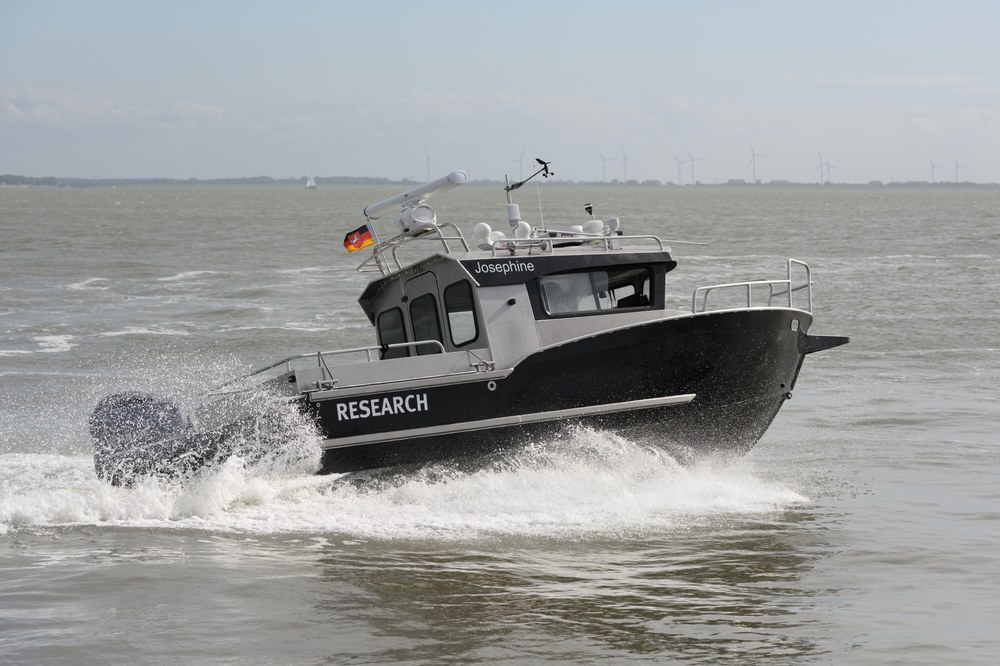eMIR – e-Maritime Integrated Reference Platform
The eMIR (e-Maritime Integrated Reference Platform) generic test field, which was designed and implemented in collaboration with the DLR Institute of Transportation Systems and the Institute of Communication and Navigation, has been used since 2014 to research and develop innovative procedures, methods and tools for the development, verification and validation (V+V) of new maritime systems.
Similar to other industries (automotive, aviation), maritime systems will also have an increasingly high degree of automation in the future and enable the systems to react directly to influences from their physical environment, such as the current traffic situation. This poses new challenges for development departments and certification bodies. There is currently still a lack of validation procedures that provide proof of the functionality (verification) and practical suitability (validation) of such highly automated systems during their development and are suitable for certification. However, such validation procedures are essential in order to comply with safety requirements and to promote trust in such systems. Accordingly, efficient procedures, methods and tools for V+V must be researched and made available.

As an internationally recognised maritime test field, eMIR offers industry, small and medium-sized enterprises and research institutes the opportunity to research and develop highly automated maritime assistance systems and concepts for autonomous ships. These can be tested under virtual and real conditions in eMIR.
Functions that arise during the development of automated systems and technologies are successively trialled using the test field. eMIR offers three main areas of application in the research and development of such systems and technologies: Data collection and analysis, conducting simulations and physical experiments, and testing and demonstration. eMIR is to be further expanded in cooperation with the DLR institutes of Communication and Navigation and Protection of Maritime Infrastructures, among others, for the topics of sensor data integration, platforms, data exchange and testing areas at sea. It is also to be supplemented as a large-scale research infrastructure with services for harbour sensor technology, communication technology, high-precision maps, etc.
Data collection and analysis
Various data on ship movements and environmental conditions are collected and evaluated as part of a long-term analysis in order to gain a better understanding of the environment for which a new system is to be developed. This data is used to draw conclusions about how often and under what circumstances certain situations occur. Basic traffic patterns are examined, especially with regard to human behaviour and the associated human-machine interactions. This requires extremely high-quality data collection: the more comprehensive and accurate the data sets are, the better they allow maritime traffic to be analysed and the more stable their basis for scientific modelling. This large amount of data is needed in particular to train self-learning systems.
Carrying out simulations and physical experiments
eMIR supports the necessary research and development processes for automated system functions and technologies throughout the entire development process. With its comprehensive and integrated test field consisting of two components, eMIR enables simulations and physical experiments to be carried out. The virtual part, HAGGIS, is based on a co-simulation infrastructure using High Level Architecture (HLA). LABSKAUS, the physical part, can then seamlessly access the HAGGIS elements. The entire test process therefore moves successively and as seamlessly as possible from virtual to physical tests. This gradual approach to testing automated system functions and technologies promises successful and meaningful test results because the transition from simulations to real experiments is not ad hoc. Known and newly developed V&V methods can be used in all phases of the development process based on X-in-the-Loop. eMIR also provides methods for ensuring the validity of the test field components used. In this context, validity means that the experiments conducted in the virtual and physical test field deliver results that contain reliable and transferable information about the behaviour of the systems under investigation in the real world. The open test field design of eMIR supports a systems engineering approach with regard to new technologies, co-operation schemes and human-machine interfaces, on the basis of which the overall system can be tested at the end of the test phase. The advantage of this successive testing method is that experiments can initially be carried out without restriction in simulations, which are significantly more cost-effective than physical tests. In addition, there is virtually no potential risk of danger in the virtual test field and the mass tests required for the statistical evaluation of new methods can be carried out. eMIR uses a common data model based on the international S-100 standard for maritime data exchange. The HAGGIS simulators are operated at the DLR site in Oldenburg and at the Federal Maritime and Hydrographic Agency (BSH) in Hamburg. LABSKAUS covers the area of the Elbe between Brunsbüttel and Cuxhaven and the sea area between Cuxhaven, Wilhelmshaven and Helgoland. On Schillig Reede and west of Helgoland, the construction of further physical test fields for research into autonomous shipping is planned in cooperation with the Jade-Weser-Port.
Testing and demonstration
Automated systems can be demonstrated and evaluated with eMIR for their use in industrial processes and applications. eMIR offers the possibility of demonstrating the functionality and practicality of new products for sales support. The combination and cooperation of the eMIR maritime test field and automotive test fields (Test Field Lower Saxony) will ensure that one of the world's largest interconnected test fields for automated and autonomous transport is formed. The linking of automotive and maritime research activities ultimately creates the opportunity for joint investigations into multimodal freight transport and at the same time allows scientific findings to be utilised as natural synergy potential. This plays an important role in automated port operations based on intelligent autonomous freight vehicles. While today's systems only operate in limited, precisely defined contexts, in future they will be able to do so in partially and later even completely unknown contexts.
